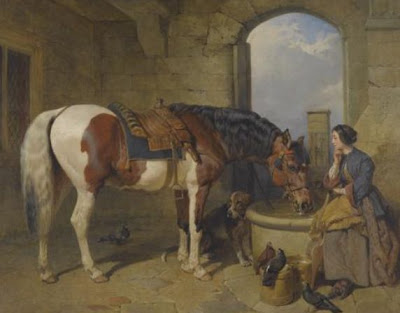
signed and dated u.l.: J.F. Herring Sen.r 1855.
oil on canvas
86 by 112cm.; 34 by 44in.
ESTIMATE 100,000 - 150,000 GBP
The skilfully rendered present work was painted following Herring's move to Meopham Park in Kent. Having become frustrated with the urban tumult of city life in London and the increasingly bothersome effects of his recurring asthma, Herring purchased an idyllic Georgian house near Tonbridge. The estate was set within thirty
acres of land and came complete with walled pleasure gardens, an orchard, a farm yard, cow houses and a saddle room. The artist was there surrounded by his family, who he often used as models, in particular his youngest daughter Jennie who married Mr Warner, a local solicitor in 1857. Jennie was likely the model in Shoeing Imaum of
1856 (sold in these rooms, 17 December 2009, lot 66, for £481,250), and while the contemplative sitter in the present work is unidentified, their delicate features are strikingly similar.
By 1855, the year the present work was painted, Herring's reputation as one of Britain's foremost equestrian painters was well established. He had been appointed animal painter to H.R.H. the Duchess of Kent (mother of Queen Victoria) on 29 May 1845. This was followed by a commission from Queen Victoria herself, who was
thereafter a patron of the artist's equestrian work until his death in 1865. This reputation remained with him even after he retreated to the country to spend his golden years. Indeed, when William Powell Frith was painting his famous Derby Day in 1857 he went to Herring for help with the rendering of the horses.
While he continued to paint the occasional race-horse portrait and exhibit periodically in London (as the major dealers were only a short train ride away), Herring's move to the country sparked a change in subject matter. The present work, in its cosy nature, is an excellent exemplification of the romanticized farmyard scenes Herring began to depict using a looser, more fluid, style. The stone walled stable is pristine. The thrust open door allows warm dappled light to fill the space, and offers a view of the blue sky strewn with white clouds. The skewbald horse's coat gleams with health and life; the family dog is shy and deferential; and the birds go about their meal in a tidy and orderly manner. While the anatomy of the horse is still depicted with Herring's typical precision and the various
effects of fur and feathers have been well observed, there is an increasing naturalism and ease in the pose of the animals. Interestingly for Herring, the saddle itself is a western style saddle, as indicated by the stamped detailed
leather and the prominent horn and pommel.
Herring's prodigious level of output during his final years in Kent suggests the subtle change in subject matter was exceptionally popular. In particular, these scenes attracted the new urban middle classes and important patrons such as the Duc' d'Orleans, who were desirous of idealized depictions of the simpler rural life. One can imagine these nineteenth century urban dwellers staring wistfully at the present work, which is truly one of the finest examples from Herrings late period of productivity.
No comments:
Post a Comment